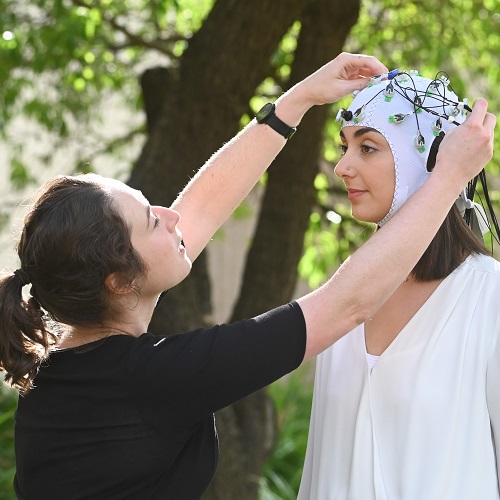15 May 2023

Photo by Catherine Leo
Ever walked into a room and immediately felt energised, calm, or drained? What if the design of the building was making you feel that way? While it is estimated we spend at least 80% of our lives indoors, there is not much research on the impact this has on our brains and bodies.
Next week, University of South Australia (UniSA) postdoctoral researcher Dr Isabella Bower will address this important gap in knowledge, explaining to local Adelaide pub patrons how aspects of built environment design (like the size or colour of a room) affect us.
Dr Bower is one of three UniSA researchers stepping out of the laboratory and into the Wheatsheaf Hotel in Thebarton as part of Pint of Science Australia, returning for its eighth year, from 22-24 May 2023.
Pint of Science is an international festival held in more than 400 cities worldwide. This year, the Pint of Science Australia festival will take place in 30 pubs across 15 cities, including Adelaide. Attendees will be able to enjoy a pint of their favourite beverage while listening to fascinating talks from science communicators and experts in their respective fields.
“My research explores whether we can improve brain functioning and mental health by understanding the impact that building design has on us,” Dr Bower says. This includes places like our homes, offices, schools, and hospitals.
Using virtual reality to change interior environments and other specialist equipment to record temperature, humidity, air movement, and sound levels, Dr Bower has been undertaking a series of experiments to better understand the impact of being inside a building. This includes changes in brain activity when performing a task in those spaces, reminiscent of something we might do daily – like concentrating on writing a difficult report for work or trying to determine a colleague’s facial expressions.
“Electrodes on the scalp detect brain activity in different environments, providing information about attention, cognitive performance, and emotional processing. Heart rate, breathing and sweat response also reveal how people respond to certain settings, even without being aware of it.”
The information gleaned from these experiments will hopefully one day be used to design better buildings – where people are happier, healthier, and can optimise their abilities.
Dr Bower’s field is broadly termed ‘environmental psychology’, an emerging field of research investigating the relationship between individuals and their physical settings, including both natural and human-made environments such as buildings.
“Although this field of research is relatively young, it continues to increase as research on climate change and virtual environments expands.”
Dr Bower says she hopes her research will one day lead to psychological guidelines for the design of buildings, translating the science into policy and practice, highlighting the importance of good design for human health and cognition.
“We spend at least 80% of our time indoors, so it is important we get it right. This research has the potential to make a huge difference to the lives of people across society.
“How are rooms affecting jury decisions, students’ performances in exams, and patients’ ability to recover in a hospital? These are all very real scenarios that we need to research more deeply.”
Dr Bower will present her research findings, Buildings and Brains, on Monday 22 May at the Wheatsheaf Hotel, 6.30pm as part of the Optimise Your Mind session. She is also hosting a special online event in the lead up for the festival on Wednesday 17 May, 12:00pm, Shining the light on Environmental Psychology in Australia.
Two other UniSA researchers will also deliver Pint of Science talks on Tuesday 23 May at the Wheatsheaf Hotel as part of the Battling the Bugs sessions:
The Unexpected Talent of Lymphatic Vessels
Centre for Cancer Biology postdoctoral researcher Dr Anna Oszmiana and colleagues have discovered a site in DNA which controls the lymphatic vessels’ ability to produce blood cells. This opens new possibilities for treating infections and anaemia.
Seeing the Invisible Bacteria with Tiny Fat Droplets
UniSA PhD candidate Santhni Subramaniam is using nanotechnology to help deliver antibiotics within small fat droplets across the cells, more effectively targeting elusive harmful bacteria in the body.
To book for the Pint of Science Festival in Adelaide, go to: https://pintofscience.com.au/events/adelaide
…………………………………………………………………………………………………………………………
Media contact: Candy Gibson M: 0434 605 142 E: candy.gibson@unisa.edu.au


